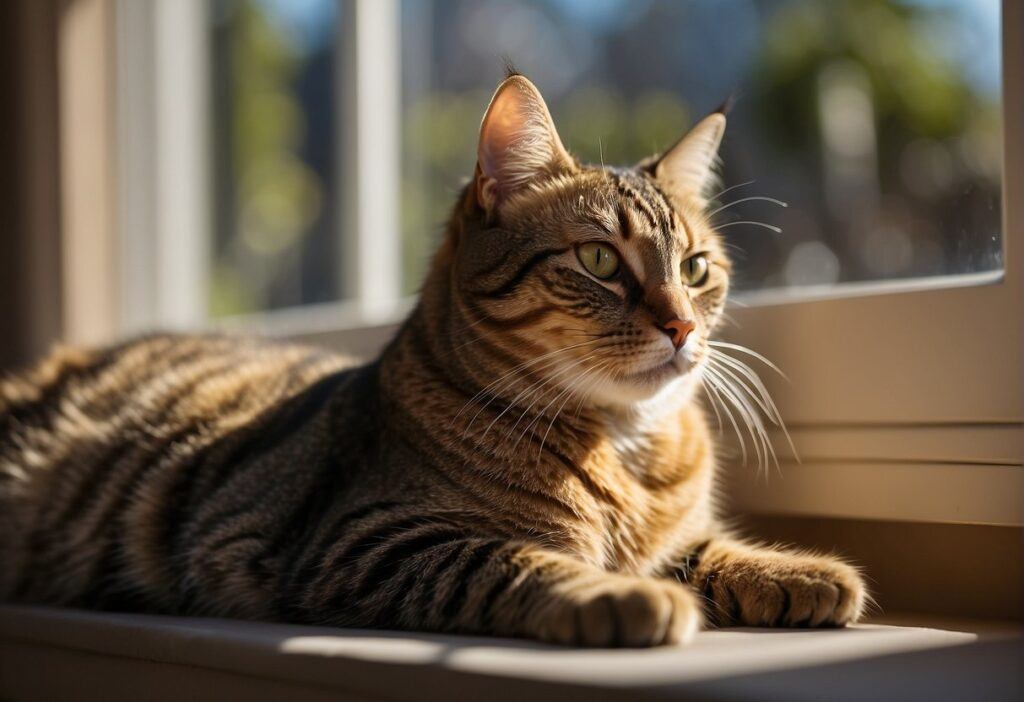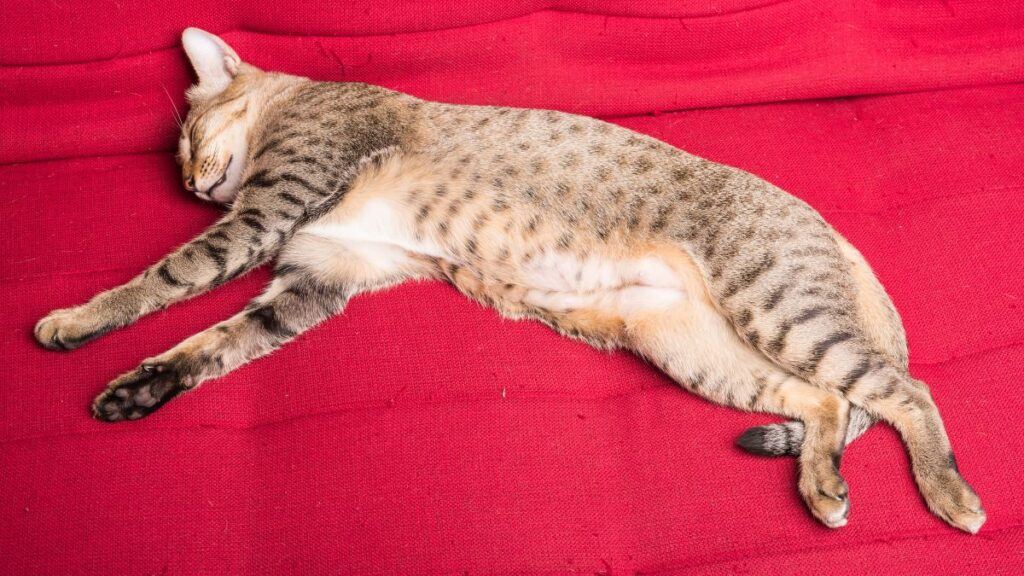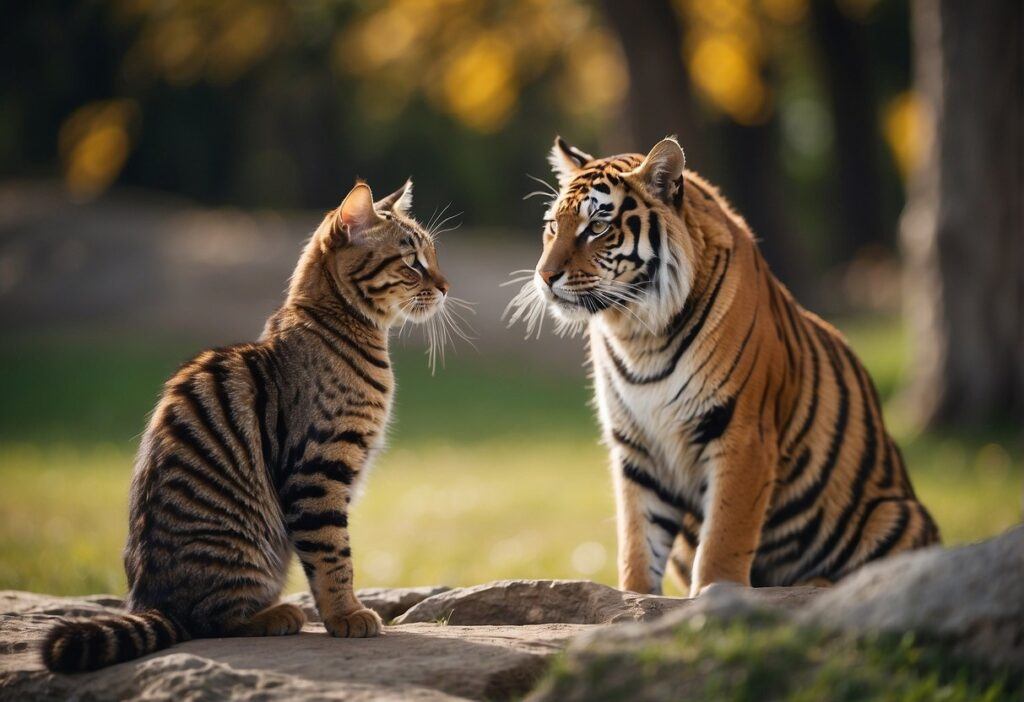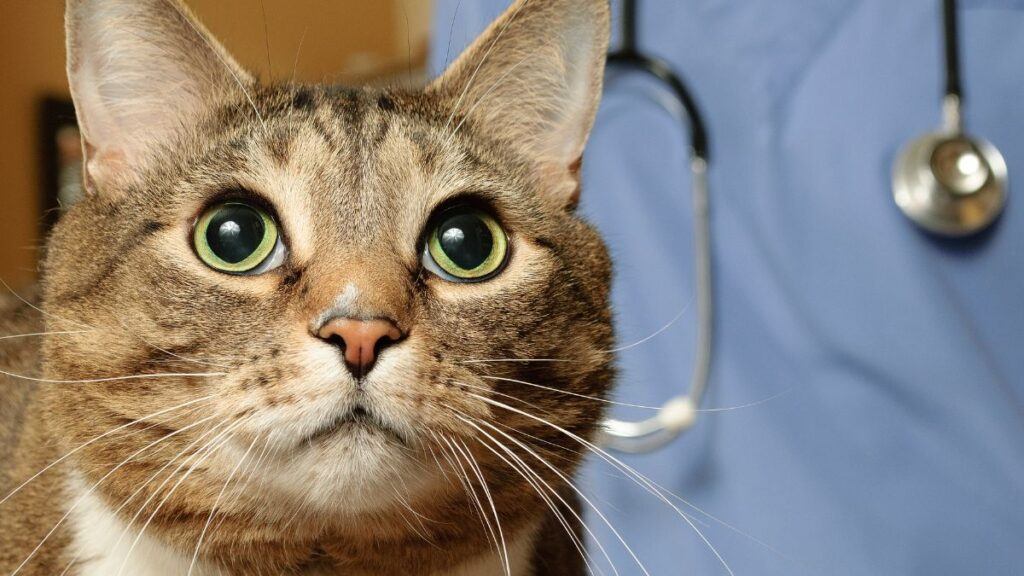Domestic cats exhibit various coat patterns, among which the tabby pattern is the most common.
‘tabby’ refers to a coat of distinctive stripes, dots, lines, or swirling patterns, often with a symbolic ‘M’ mark on the forehead.
These patterns are not exclusive to any particular breed and can appear in various domestic cat breeds.
Tabbies are known for their striking patterns resembling their wild ancestors’ camouflage, which served as a natural defense in grasslands and brush.
However, the term ‘tiger cat’ can lead to some confusion. It is sometimes colloquially used to refer to tabby cats with a specific stripe pattern reminiscent of a tiger’s coat.
On the other hand, ‘tiger cat’ can also refer to certain wild cats, such as the South American oncilla.
It is important to differentiate between domestic cats with a tabby pattern that might be informally called ‘tiger’ and actual wild cats that belong to distinct species entirely separate from the domestic cat lineage.
Tabby vs. Tiger Cat
Understanding Tabby Cats

Tabby cats are known for their distinctive coats due to specific genetics. Their unique patterns and personalities lend to a diverse group of felines adored by many.
Genetics of the Tabby Pattern
The tabby gene expresses itself in the agouti pattern, where individual hairs show alternating bands of color.
The dominant gene in tabby cats determines the tabby markings, with agouti hairs being a key factor in this visual distinction.
There are also recessive genes that play a part, though the dominance of the tabby gene is most evident in the coat patterns.
Common Types of Tabby Patterns
There are several tabby patterns, each with its typical markings:
- Mackerel tabbies feature narrow stripes running in parallel down their sides, resembling a fishbone pattern.
- Classic tabby cats boast a whirl or marble pattern with wider, swirling bands.
- Ticked tabby coats show coloration on the tips of the hair with less defined stripes on the body.
- Spotted tabbies display spots of various sizes and shapes across their coats.
- Patched tabbies, often female, exhibit patches of different colors, including orange or cream.
Tabby Cats and Personality Traits
While personality traits vary widely in cats, some believe that tabby cats may share common behavioral tendencies.
However, cat personality traits are affected by many factors, including breed, environment, and upbringing.
Consequently, tabby markings alone are not reliable indicators of specific personality traits.
Tiger Cats: Defining Features

Tiger cats exhibit distinct coat patterns that are often confused with those of their wild counterparts.
These domestic felines bear a striking resemblance to the African wildcats in terms of their fur marking.
Distinguishing Tiger Cat Patterns
Tiger cats, often called striped tabby cats, display a unique fur pattern that sets them apart from other domestic cats.
The tiger cat tabby pattern is characterized by bold, dark stripes against a lighter background.
The stripes may vary in width and continuity but generally follow a pattern reminiscent of a tiger’s coat. Here is a comparison of typical tiger cat patterns:
- Mackerel tabby: Narrow stripes run parallel to each other like fish bones.
- Classic tabby: Swirling patterns appear on the sides, giving a marbled look.
- Spotted tabby: Stripes break into spots, which can vary in size and shape.
- Ticked tabby: Individual hairs are striped, giving a speckled appearance, though not considered as striped as other patterns.
Tiger-Cats in the Wild vs Domestic Sphere
In their natural habitat, the resemblance between tiger cats and African wildcats is both cosmetic and functional, providing camouflage to blend into the environment.
On the other hand, while sharing the same coat patterns, domestic tiger cats do not rely on their stripes for survival.
They have been selectively bred over generations for these appealing markings rather than for environmental advantages.
Domestic tiger cats generally exhibit similar temperament and behavior to other domesticated felines, vastly different from their wild relatives.
Different Breeds and Variations

Different cat breeds exhibit a spectrum of coat colors and patterns. Tabby patterns are common in various breeds, while intentional breeding influences the emergence of specific color traits.
Notable Cat Breeds Sporting Tabby Coats
Noteworthy domestic cat breeds with tabby coats include the Maine Coon, American Shorthair, and Egyptian Mau.
The Maine Coon is often found with a mackerel or classic tabby pattern, showcasing thick, lush fur with wide stripes and a distinctive ‘M’ on its forehead.
The American Shorthair, known for its robust health and affectionate nature, displays various colors including the common silver tabby.
The Egyptian Mau bears a striking spotted tabby coat, a rare and natural breed characteristic that emphasizes athleticism and elegance.
The Impact of Breeding on Coat Colors
Breeding has a substantial impact on the coat colors and patterns exhibited by cats. Calico cats, often females due to the genetic characteristics associated with their tri-color pattern, showcase a mix of white, black, and orange fur.
American Bobtails, which have a wild appearance and a bobbed tail, can come in any color or pattern, including tabby.
Bred for their exotic look reminiscent of wild leopards, Bengal cats exhibit rich orange to dark colors with distinct spots or marbling.
Coat colors in domestic cats can range from solid hues to bi-color or even tri-color patterns, heavily influenced by selective breeding practices.
The array of colors spans white, black, blue, red, cream, and the various shades and combinations associated with the tabby pattern.
Health and Care for Tabby and Tiger Cats

Proper health care and grooming are fundamental to the well-being of both tabby and tiger cats.
This section provides owners practical guidelines for vet visits, common health issues, grooming, and litter box training.
Regular Vet Checks and Health Concerns
Regular vet checks are crucial for domestic tabby cats and tiger cats alike. These checks can help identify and address health concerns early.
- Frequency: At least once a year for a general check-up, more frequently for kittens and senior cats.
- Common Health Concerns:
- Obesity: Monitor their diet and ensure regular exercise.
- Dental Issues: Regular dental checkups and cleanings can prevent diseases.
- Parasites: Watch for signs of fleas, ticks, or worms.
Pet owners should also be aware of specific genetic health predispositions in their cats, such as heart problems or kidney diseases, which may require specialized attention.
Grooming Tips and Litter Box Training
A well-groomed cat with a clean litter box is a happier, healthier cat. Here are some tips for grooming and litter box training:
- Grooming:
- Brush regularly to reduce shedding and hairballs and to keep their fur pattern sleek.
- Trim nails to prevent overgrowth and scratching of furniture.
- Litter Box:
- Place the litter box in a quiet, accessible location.
- Clean it daily to encourage use and to maintain hygiene.
Tabby and Tiger Cats in Culture and History
Tabby and tiger cats have played influential roles in human culture and history, from symbols of divinity to everyday companions.
Symbolic Significance and Folklore
Tabby cats are often recognized by their distinctive coat patterns, featuring stripes, swirls, and dots.
The term “tabby” derives from a striped silk fabric that originated in Baghdad, named after the Attabiy district.
Ancient Egypt revered cats; the tabby pattern may remind us of their wild ancestors.
Stripes similar to those on tabby cats can be found in depictions of the Egyptian Mau, one of the oldest cat breeds, often associated with the sun god Ra, which represents light and warmth.
In Christian folklore, a common tale refers to a tabby cat warming the baby Jesus and earning the Virgin Mary’s blessing.
This tale is thought to explain the ‘M’ often found on the foreheads of many tabby cats.
This particular characteristic has enriched the imagery and stories of tabby cats in various cultures, casting them as sacred or mystical creatures.
Historical Significance of Tabby and Tiger Cats
Throughout history, tabby and tiger cats have been omnipresent as domesticated pets and symbols.
In medieval Europe, cats, including tabbies, controlled populations of rats and mice.
They indirectly protected granaries and prevented the spread of disease. Thus, they became symbolic of good fortune in agriculture and homestead protection.
Domestic shorthair cats, including many tabby-patterned individuals, are among today’s most common cat varieties.
They are not a specific breed but a category of cats with varied ancestry. They are often admired for their robust health and adaptability.
The tiger tabby cat, with bold stripes resembling the majestic wild tiger, embodies strength and independence, traits valued in history and modern culture.
Tabby and tiger cats have secured their place in historical records and cultural symbolism through their symbolic ties to deities and their ever-present role as companions.
Introducing Cory Haasnoot, a devoted father, loving husband, and enthusiastic cat lover. As a key content creator for CatFurLife.com, Cory blends his family values and passion for felines into engaging and informative content. He brings a unique perspective to the site, sharing cat care tips and how cats can enrich family life and bring joy to households.

